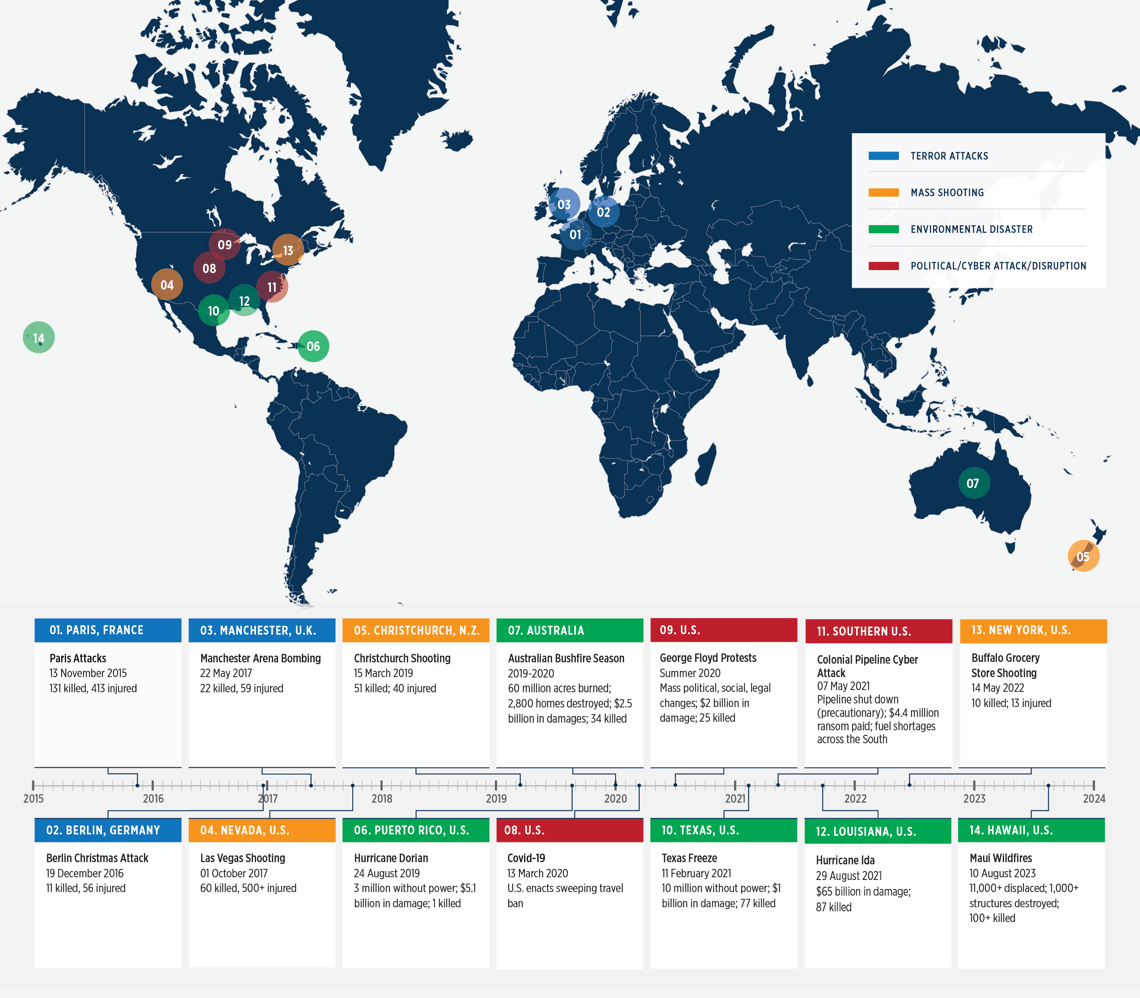Even in destinations with seemingly low risk, it is essential for corporations to have robust travel risk management protocols and response plans in place as part of their duty of care obligation to their workforce.
BY Dale Buckner, President and CEO

Last week, fires swept across the Hawaiian Island of Maui, causing substantial damage to property, and tragically, a significant loss of life. The devastation this disaster wrought in an otherwise peaceful location exemplifies two key and inter-related points. First, that risk is ever present — even “Low Risk” destinations are not immune from crisis and calamity.
Second, human nature often skews and obfuscates our abilities to manage everyday risk. We fear and put more energy into worrying about rare events like shark attacks or plane crashes over more frequent risks like car accidents. While there are around 80 shark attacks globally (with minimal fatalities) and very few plane crashes each year, car accidents are ubiquitous, accounting for over 1.3 million deaths annually. This disparity underscores the cognitive bias where attention is disproportionately given to the extraordinary, causing misjudgments of real-world dangers that decision-makers must recognize to protect their employees, assets and reputations.
Business cycles can be predicted, travel to austere locations can be avoided or modified with appropriate security measures, but there are some threats that simply cannot be controlled for. Some threats, including crime, unrest, war, terrorism, and active shooters are anthropogenic (human caused). Nature itself – sometimes with human assistance – can be the progenitor of other threats, like storms, earthquakes, floods and fires. Crises can happen anywhere. Some are bound to geography, some are not, and can just “happen.” Nominally, this is what insurance is for. But often insurance does not cover, injury or loss stemming from conflict, terrorism, or natural disasters. It is, therefore, imperative to know what IS and what IS NOT covered before you send employees on travel, even to locations classified as “Low Risk.” Anything can happen, anywhere, at anytime.
Crisis Events in Low-Risk Destinations

The last decade has seen a multitude of major security events impact topline businesses in ostensibly “safe” locations. Human-caused disasters – including terror attacks, mass shootings, cyber-attacks, as well as political/governmental-related disruptions – and natural disasters have been occurring at an increased rate over the last half-decade or so. That these events can occur with little to no warning necessitates preexisting plans of action, as well as a nuanced and inter-disciplinary understanding of risk and the vectors from which it arises. The risks trends we see are dynamic, not linear. We’ve seen an overall decrease in mass causality terror attacks in the West over the last decade, but environmental events are becoming more frequent with climate change. (We know that eight of the ten largest wildfires in California history have occurred in the last five years.) Political crises, too, are shifting in their scope and impact. The war in Ukraine, for example, has had huge second order effects on countries from the Sahel to Central Asia. The American presidential election, coming next year, will impact the world’s major geopolitical flashpoints - namely, China, Russia, and Iran - in ways we do not yet understand. The events these flashpoints trigger will in turn present the business community with a litany of new risks in an increasingly complex and unpredictable world.
In this ever-changing security environment replete with ever-present risk, an organization’s duty of care to its employees is becoming a legal, ethical, and reputation minefield. Insurance, “experience,” and relying on existing contingency plans is often not enough. While mission success cannot ever be fully guaranteed, having a proper plan in place – and testing it out beforehand – is the best way to achieve results in any crisis situation.
Even when the risk is seemingly low in the destination, corporate travel shouldn’t even be considered until you can definitively, and more importantly, confidently, answer the following questions:
- If an employee were to misplace or have any important travel documents or work-related items—such as a passport or work phone—stolen, what protocols are in place to support that traveler? And does the traveler know what to do?
- If an employee encounters a medical need or emergency—from an illness to injuries sustained in an accident—how will they receive care and how will they be medically evacuated if needed? Do your vendors have assets around the world to quickly execute?
- If an employee is stranded due to a major crisis—such as an active shooter, natural disaster, or political unrest—who will assist and bring them to safety? How will their situation be communicated to their families and to other parts of the firm?
Planning is critical but so is the ability to respond quickly in times of crisis. Your response vendors and partners should have the systems in place to support in real-time, no matter the severity of the situation.
Bottom line: Crisis planning and emergency response is not a nicety; it is a necessity.
Standing by to Support
The Global Guardian team is standing by to support your travel risk management requirements, including:
- Duty of Care Membership
- Travel Alert and Monitoring Platform
- Medical Evacuation
To learn more, complete the form below or call us at + 1 (703) 566-9463.



